°Arcus°
Home » Creation stories » East Africa
CREATION STORIES FROM EAST AFRICA
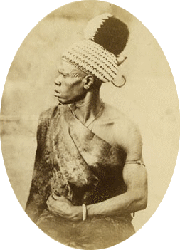
ACHOLI
In the beginning, Jok, a god (perhaps identified as the supreme being, who is given the title YA Latwer in some sources) fathered the first man, Luo. Luo became the father of Jipiti. Jipiti's daughter Kilak had a son, Lubongo, by Lubanga, the devil. Lubongo was the first of the Rwodi moo, of Rwot line of anointed chieftains of Payera.
BAGANDA
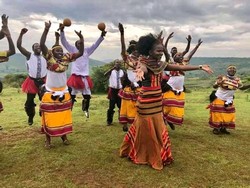
Kintu (perhaps identical to the Gisu figure Muntu) was the first man to walk the earth. He came from either the north, west or east, bringing with him the items needed to produce a civilisation: cattle, millet and bananas. The first cow gave him milk to sustain him, before the god Mugulu or Ggulu gave him millet and bananas from the sky. Kintu then seeks to gain access to the sky, but is tested by Ggulu. He eventually manages to win the hand of Ggulu's daughter Nambi, though Kintu is opposed by Warumbe, Ggulu's son and a man whose name signifies sickness and death. They are eventually sent back to earth by Ggulu, who cautions them not to return to the sky, as that would enable Warumbe to get to the earth. Unfortunately, Nambi had left behind the millet, so they were forced to retrace their steps. Walumbe then tried to inveigle his way into Kintu's affections, in order to find his sister. This he did, and Walumbe came down to the earth.
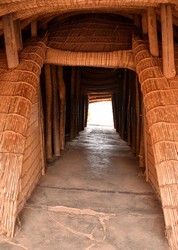
The trio first settled at Magongo, where they planted the first crops on earth. Kintu and Nambe had three children, though Walumbe claimed one for himself. His request was denied by Kintu, who promised him one of his future children. This pattern, however, would be repeated whenever Nambi bore Kintu further offspring, which caused Walumbe to become more and more exasperated, stating that all of Kintu's children would eventually be his.
Ggulu, however, had forseen what would transpire, and had dispatched Kaikuzi ("digger"), another son, to earth in order to bring Walumbe back to the sky. Walumbe and Kaikuzi eventually fought, whereupon Walumbe dug his way ever deeper into the earth to escape, with Kaikuzi in hot pursuit. He was, however, unsuccessful, and Walumbe remained on the earth.

BUNYORO
According to oral traditions from the region of Lake Victoria, the earliest civilisation which existed in the region was the Empire of Kitara, whose name means "light." This state was founded by Ruhanga, the creator, who was the first of the Batembuzi dynasty, which reigned in the region prior to the rise of the Bachwezi dynasty. This dynasty had its origins in heaven, where Ruhanga reigned. This was prior to the earth's creation, with only heaven and the underworld, the latter peopled by those cast down from heaven.
Ruhanga had a son, Isaza, who, one day, decided to explore the underworld, motivated by curiosity as to what he would find there. He remained there for a long time, meeting a princess and falling in love. However, so long did he remain, that he forgot the route back to heaven and was stuck in the underworld. The couple married, and a son - Isimbwa - was born.
Isimbwa was possessed of the same curious nature as his father, and he succeeded in finding a path back to his ancestral realm. Once there, however, he was disturbed to discover that the former gatekeeper Bukuku had usurped the throne, reigning as a tyrant. Bukuku was paranoid due to a prophecy that, one day, a descendant of his would be born who would topple him from the throne and reign in his stead. To stave off this thread, he had imprisoned his only child, Nyinamwiru, and had cut off her breasts and removed one of her eyes to render this beautiful maiden ugly.
Eventually, Isimbwa located the prison in which Nyinamwiru was being held, and became entranced by her beauty. The pair fell in love and she was rescued from her sorry estate, eventually bearing Isimbwa a son, Ndahura.
Bukuku, needless to say, was incensed at this turn of events, and launched a search for the boy. Ndahura was eventually captured, and Bukuku threw him into a river to prevent his growing up to remove Bukuku from power.
Ndahura, however, was not destined to die a watery death: the gods of heaven had seen what was taking place, and his umbilical cord had become stuck on the branch of a tree. He was rescued by one of the king's porters, who hid him away in the cave. In order to feed the boy, the gods caused a great many breasts to grow down from the walls of the cave, dripping with milk. These became known as Amabeere ga Nyinamwiru, the "breasts of Nyinamwiru."
Eventually, Ndahura grew up to be a strong, handsome young man, who eventually became a cowherd, tending to Bukuku's prized herd of cattle, which included his pride and joy, Bihogo. Unfortunately, Bihogo was attacked and killed by a lion, which left Bukuku spitting with rage and vowing vengeance on the poor fellow who had been tasked with preventing such an eventuality. This, of course, was Ndahura, and again the rightful prince was being hunted by Bukuku's loyalists.
This time, however, he was not to be found hiding in a cave: instead, he set off for the royal court and, evading Bukuku's bodyguard, he set upon the king, killing him and declaring himself king of the Bunyoro kingdom in his stead. He eventually abdicated in favour of his son, Wamala, and took himself off to the crater lakes. Wamala's reign, however, was marked by an outbreak of foot and mouth disease, which weakened the economy and enabled the Babiito to come in and take over the kingdom. Wamala disappeared into the lake which bears his name. This brought an end to the Batembuzi and Bachwezi dynasties in Kitara.
The first omukama or king of the Babiito dynasty in Bunyoro was Isingoma Labongo Rukidi, the twin brother of Kato Kimera or Kato Kintu Kakulukuku, the first king (kabaka) of Buganda.
DINKA (MUONYJANG)
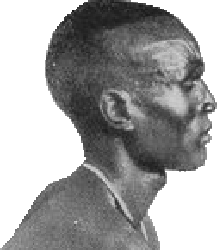
Nhialic, who is associated with the sky and rain, created the world from nothing and remains present throughout his entire creation. He controls the destiny of all life on earth, yet rarely intervenes directly within his creation. Nhialic is known among the neighbours of the Dinka - such as the Nuer and Skilluk - by a variety of other names, including Jaak, Juong and Dyokin.
The first humans created by Nhialic were Garang and Abuk, who were fashioned from the clay of the Dinka's native region, or else created by being blown from Nhialic's nose or came down from the sky and placed in the Nile. Nhialic ordered them to go forth and multiply, though cautioned them that their children would die. They would, however, return to life in fifteen days. Garang, however, protested, citing the potential lack of food which would arise from overpopulation if this were the case. Thus, Nhialic made death a permanent state.
The humans were also told to eat no more than one grain per day. However, Abuk disobeyed, making a grain paste in order to make it last longer. As a result, Nhialic severed the cord connecting heaven and earth.
Eventually, Garang and Abuk were revered as deities, with Abuk becoming patroness of gardening and women, taking on a serpentine form. Their children include Dengdit or Deng, who was associated with rain and fertility, having been given this task by Nhialic. The group of ancestral spirits are known by the term Jok.
DOROBO/NANDI
The Nandi people are inhabitants of the Rift Valley in Kenya. Their lore derives in no small part from the group's predecessors in the region, the Dorobo. The Nandi worship Asis, a sun god.
Once, Asis looked down upon the earth, which was, at that time, in a chaotic state. He resolved to bring order to this primordial planet and came down to the earth. Once on the surface, he came into contact with thunder, an elephant and a man of the Dorobo people. The former pair were rather annoyed by the fact that the Dorobo man was able to turn over in his sleep, while they had to wake up and consciously carry out this act.
Eventually, becoming terrified of this Dorobo, the thunder fled from him into the skies. This caused the elephant to mock the thunder, as the Dorobo man was, in comparison with the pair, miniscule. The thunder responded that he feared the man for he was evil. For his part, the Dorobo man was equally afraid of the thunder. With regards to the elephant, once the thunder had escaped, the Dorobo man resolved to kill the elephant, forming an arrow and dipping it in poison. Now fleeing for his life, the elephant made desperate entreaties to the thunder to spirit him up to his new home in the heavens, but the thunder, mindful of the elephant's prior mockery, refused. This led to the man killing the elephant, a situation which, sadly, still transpires to this day.
In the end, the man reproduced and his descendants became powerful the world over.
HADZA
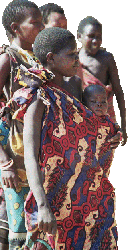
At the beginning of time, the earth was populated by a race of gigantic hirsute beings called Akakaanebe or Gelanebe ("ancestors"), who did not possess the art of making fire (primarily due to conditions on the primordial earth) or tools, but hunted game by sight: staring at a prey animal was enough to bring it down, whereupon the Akakaanebe would eat the raw meat. This people slept beneath trees.
During the second epoch, the Akakaanebe were replaced by, or evolved into, another race of giants, the Tlaatlanebe, who are distinguished from their predecessors by their lack of body hair. The Tlaatlanebe, who dwelt in caves, were able to make use of fire to cook their catch, but the animals had become more fearful of humans, necessitating the domestication of dogs to use in hunting. The Tlaatlanebe were also the earliest people to make use of magical means to protect themselves from their enemies, as well as medicine and the epeme rite.
The third epoch was the time of the Hamakwabe, who were smaller than the preceding races, and who invented bows and arrows, as well as containers for use in cooking. They built houses like the Hadza, and were the first among the Hadza's ancestors who made contact with sedentery people and/or nomadic pastoralists, with whom they traded iron to fashion weaponry. The Hamakwabe were the inventors of the lukuchuko game.
The fourth epoch includes the present, and is the time of the Hamaishonebe or "modern" people. Events during this time can be calculated by totting up the number of generations, and specific names are known for the ancestors who lived during this time.
KIKUYU/KAMBA
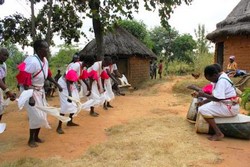
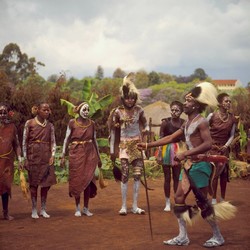
The Kikuyu and Kamba people of modern-day Kenya held that a deity by the name of Ngai, Enkai or Mwiai was the highest of the gods and the creator of the universe.
In the beginning, Ngai - also known as Mwene Nyaga or "he who possesses the light" - created humanity, beginning with the male-female pair Gĩkũyũ and Mũmbi. He also fashioned the mountain, Kĩrĩ-Nyaga (Mount Kenya), to serve as his seat on earth, from which he could survey all he had made.
Later on, Gĩkũyũ and Mũmbi married and raised a family, giving birth to nine daughters, who were matriarchs of the nine clans of the Kikuyu: -
- Acheera;
- Agachikũ;
- Airimũ;
- Ambũi;
- Angarĩ;
- Anjirũ;
- Angũi;
- Ethaga; and
- Aithĩrandũ
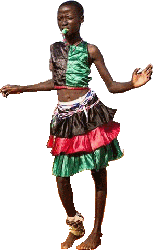
LUGBARA
All people share one blood. This was created from nothing by Andronga 'ba o'bapiri, and subsequently placed in Gborogboro (a male associated with the sky) and Meme (a female associated with earth). Meme was full of wild animals, to which she gave birth.
Afterwards, she and Gborogboro were married, and Andronga 'ba o'bapiri placed the first human children in her womb, male and female.
MAASAI
The Maasai religion features a creator, Enkai. Enkai possesses a dual nature, being both benevolent and vengeful, with this duality expressed as follows: -
- Enkai Narok - the benevolent Black God; and
- Enkai Na-nyokie - the vengeful Red God.
Black and red are also used to define the two totemic cows: -
- Orok Kiteng, the Black Cow; and
- Oodo Mongi, the Red Cow.
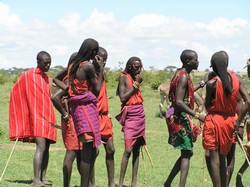
Having created the world, Enkai fashioned the first humans from a tree. This he split into three parts, from whom the fathers of the Maasai, Kikuyu and Kamba were produced. Enkai gave the Maasai father a stick for herding. To the Kikuyu, he gave agricultural implements, and to the Kamba a bow and arrows for hunting.
Other tales focus on a conflict between the dual aspects of Enkai, from which Enkai Narok emerges victorious.
MALAGASAY
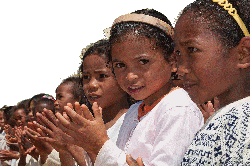
One day, the creator saw his daughter making small dolls from clay. He was so impressed, that he blew the breath of life into them, creating the first humans. Eventually, the daughter grew up and became the Earth Mother, while the people multiplied and lived upon her, worshipping her. Unfortunately, this caused her father, the creator, to become jealous. A compromised was reached whereby the souls of the people would belong to him. Thus, anyone whose soul he wished to take, he would take, leaving that person's body to return to the Earth Mother.
NUER
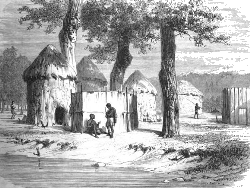
This god is known as Kuoth Nhial ("God in Heaven"), who makes himself manifest through thunder, lightning and rain. The rainbow is said to be his necklace, while the sun, moon and other parts of the material universe represent manifestations of his spirit.
Among the lesser spirits, those of the air are most powerful. WiW is a spirit of thunder and warfare. When humans die, their spirits return to Kuoth Nhial.
NYAMWEZI
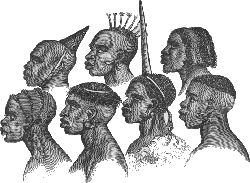
The Nyamwezi are a people of Tanzania. They know of a creator, Shida Matunda, who fashioned the universe from nothing.
Later, his favourite wife, the first of them, passed away. Overwrought with gried, Shida Matunda buried her body in a hut and watched over the site, watering the tomb on a regular basis. This led to the emergence of a plant from the grave, which led Shida Matunda to realise that his deceased wife would be reborn.
All the while, however, Shida Matunda's second wife had followed his orders that she stay away from the grave. This, combined with his observations there, led her to become increasingly jealous. One day, she inveigled her way into the hut and chopped down the plant. From it, blood emerged and filled the hut. Shida Matunda was incensed, telling her that, by doing this, the second wife had prevented the rebirth of her rival and brought death into the world.
PANGWA
In the beginning, there was the Word. The Word was the master of the universe. Alongside the Word were the wind and a tree, in which dwelt ants. The wind grew annoyed with the tree for standing in its way, so it tore off a branch in which white ants lived. The ants landed and grew hungry, so proceeded to eat the leaves from the branch, all bar one, upon which they left a huge mound of excrement.
Eventually, hunger caught up with them, compelling them to chow down on their dung, which caused this pile to eventually grow to mountainous proportions, spreading as far as the original tree. The pile continued to grow, as the ants now had a taste for droppings. Thus, eventually, the pile grew to form the earth as we know it. This world was blown by the wind, which dried the excrement to form stone. The Word then sent snow and warm winds, which melted the snows, forming the waters of the earth. These, however, came in the form of a deluge, which killed the ants.
Subsequently, the earth and world tree joined together, and the world took on the form it has today, with the vegetation and water courses. The air gave birth to a group of beings which flew about singing. These came to earth, becoming animals and humans.
These new life forms, however, were hungry. The animals wished to eat the Tree of Life, but the humans defended it, leading to a great war between the two. This war resulted in the earth beginning to shake violently, becoming hot and casting off material, from which the sun, moon and stars took shape.
After this, a variety of gods were brought into being, along with rain, thunder and lightning. The latter two were the result of a one-horned sheep leaping into the air and catching fire.
The new gods were cruel towards humans, misinforming them that the sheep leaping into the air had resulted in the death of the Word, and that the people would become smaller and that, eventually, the world would be consumed in a great fire.
SHILLUK
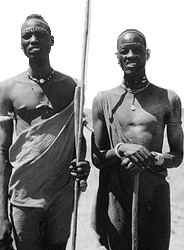
At an early period in the earth's history, Dhyang Adugø or Dean Aduk, described as a white cow, gave birth to a gourd, from which emerged a man variously named as Köölø or Pöölø. He was the father of Omaarø, who fathered Wäd Möölø, himself the father of Okwä.
One day, Okwä visited the bank of a river and met Nyikaayø and Ongwak, two long haired females whose bodies had both human and crocodilian traits. Okwä attempted to abduct them, but could not do so before they had raised the alarm, alerting their father Dunyel Ju'Okwa, whose right side was human and his left that of a crocodile.
Eventually, Dunyel and Okwä agreed upon a substantial dowry for the pair, whereupon Okwä married the pair. By Nyikaayø (who dwelt at the confluence of the White Nile and Sobat rivers), he became the father of the culture hero Nyikang, variously Okwä's eldest or youngest son. Dïwäädɔ or Duwat was regarded as Nyikang's twin.
Some time later, Okwä died, whereupon Nyikang and Dïwäädɔ contested the succession, the latter emerging victorious. Nyikang refused to swear allegiance, deciding instead to leave Dïwäädɔ's domain. As he left, Nyikang threw a pile in Dïwäädɔ's direction, which he subsequently took and used it to plant crops.
Nyikang and his family came to a land ruled by a sorcerer by the name of Dïmø. It was there, near the confluence of the White Nile and Sobat, that Nyikang and his son, Daagø or Dak, founded the Shilluk Kingdom.
SWAHILI
God has always existed and carries out acts of creation simply by speaking. His first utterance was "Let there be light," and there was light. The light pleased God and he allowed some of it to enter into Muḥammad, who was to be his prophet. The light was placed within Muḥammad's soul, which so pleased God that he decided to fashion humanity so that Muḥammad could serve as their teacher.
After this, God began to create the things necessary to fulfil his purposes. He made the Throne of Heaven and placed it upon a carpet of every colour. The souls of the righteous were to dwell forever in the shadow of this carpet. Next, God created the Mother of Books, which had a soul, and the Pen, with which to write down his ommandments. Thereafter, the Trumpet was created along with Serafili, the angel who will blow it on the last day. The other angels too were made, including Jiburili, Maliki and Zeraili.
Next, God created the world, by rolling out the sky and setting sun, moon, stars and planets upon it, with seven heavens above, watched over by the souls of Adam, Isa, Yahya, Yusufu, Idrisi, Haruni and Musa, with Abraham set in the highest heaven. There were also seven hells corresponding to these heavens. Finally, God made Adam's body from clay and spoke the word "life" to bring him to consciousness.
